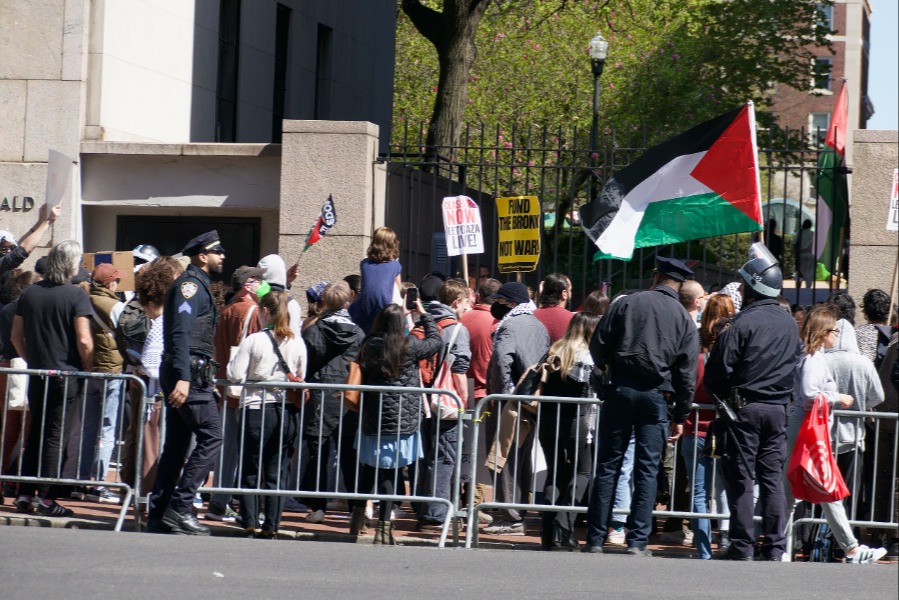An Abridged History of America’s Terrorism Prevention Programs: Opposition Grows, Supporters Adapt
As the U.S. government faces downsizing in both its terrorism prevention staff and congressional funding, a quiet shift has begun at the local level. The future of CVE programs will be determined by state-level and city initiatives.

Published by The Lawfare Institute
in Cooperation With

The following is a modified excerpt from a new book, “Homegrown: ISIS in America.” To read the first part of the excerpt, click here.
While the Group of Four was attempting to coordinate programs in Washington, D.C., a more organized and sophisticated effort was building in advocacy and community groups around the country against countering violent extremism (CVE) programs. The organizations that opposed the initiatives of the pilot city programs did not view countering violent extremism as a good-faith effort by the federal government to find alternatives to “counterterrorism as usual,” but as an extension of typical counterterrorism efforts.
As the CVE strategy was rolled out nationwide, concerns among civil rights activists and Muslim American organizations grew regarding the strategy’s implementation in local communities and over the direction of the strategy more broadly. Responses ranged from calls for greater institutional checks from civil society on government programs to ending CVE as a strategy altogether. One of the criticisms most commonly raised among counter-CVE activists was, and continues to be, that only Muslim communities are highlighted and stigmatized as suspect communities.
Those concerns and criticisms continued to rise after the initial 2011 Strategic Implementation Plan release. By 2014, just as the Three-City Pilot in Boston, Minneapolis-St. Paul and Los Angeles was beginning to take shape, protests quickly followed. Organizing under the hashtag #StopCVE, local activists and organizations in each of the three cities staged protests and raised awareness online. In addition to framing their protests as a struggle for human and civil rights, community organizers and legal advocates also tried to situate the post-2011 CVE wave within the context of the “war on terror.” By connecting the counter-CVE struggle to the longer history of America’s domestic counterterrorism efforts, activists tapped into the fears and lived experiences of Muslim Americans across the U.S. over a decade in the making. When the 2015 interagency CVE Task Force was announced, the FBI’s “Shared Responsibilities Committees,”—modeled on the U.K.’s “Prevent’s Channel Panels” for referrals of community members identified as susceptible to violent extremism and tailored intervention—received some of the greatest condemnation from activists.
In Boston, the Muslim Justice League—formed in 2014 “in response to a pressing need for local Muslim-led defense of our communities’ human and civil rights against the ‘War on Terror’”—drew support from a number of members, individual donors, and foundations such as the Hyams Foundation, the Episcopal City Mission, the Barr Foundation and others. The Muslim Justice League went on to receive a seed grant from the Harvard Law School Public Service Venture Fund in 2015. In addition to organizing protests, the group also provided “Know Your Rights” workshops and pro bono legal representation to community members who had been approached by the FBI.
A Muslim advocacy group called the Council on American-Islamic Relations (CAIR) soon took the lead in organizing resistance to CVE measures in Minneapolis, forming a coalition of more than 40 organizations of varying sizes based in the Minneapolis area or in Minnesota more broadly. These organizations co-signed a letter penned by CAIR to CVE-affiliated organizations addressing concerns over what they deemed the “stigmatizing, divisive, and ineffective CVE Pilot Program” being implemented in Minneapolis’s Somali American community. Perhaps the most sophisticated resistance to CVE, however, came from Los Angeles. Since April 2016, #StopCVE had been organizing opposition protests, but in June 2018, a petition was circulated criticizing the Los Angeles Mayor’s Office of Public Safety, Human Relations Commission, and Police Department for failing to release documents regarding the federal CVE grant to the city.
This resulted in a lawsuit, filed on June 28, 2018, claiming that the City of Los Angeles had uncritically adopted CVE measures without community transparency. The lawsuit also aimed to publicize the funding stream of the city’s CVE efforts in order to analyze and assess the program’s impact on Los Angeles communities. By August of that year, responding to the pressure, the City of Los Angeles announced it would not accept CVE funding.
Though not part of the Three-City Pilot, Chicago also witnessed significant counter-CVE resistance to the Illinois Criminal Justice Information Authority’s (ICJIA’s) Targeted Violence Prevention Program (TVPP), a Homeland Security-funded initiative that in many ways rebranded CVE efforts in the city. The TVPP built on the ICJIA’s experience with gang prevention models in Chicago’s south and southwest neighborhoods, which alone drew significant backlash on the basis that the two issues are different and vary in scope. The relatively unsuccessful track records of gang prevention models certainly did not alleviate these concerns. In this environment, the #StopCVE coalition in Chicago was able to draw on a number of organizations, including CAIR, to organize and resist CVE locally. However, CAIR had its own internal disagreements on CVE. Its Florida chapter had applied for federal funding for CVE, and individual chapters had advocated for the same approach that the national office was campaigning against.
In a 2017 article for Just Security, Faiza Patel, co-director of the Brennan Center for Justice’s Liberty & National Security Program, summed up many of the sentiments expressed by advocacy and community leaders nationwide. Patel, a thought leader in the countering-CVE movement, identified three fundamental reasons why she believed countering violent extremism is bad policy. First, she stated that CVE programs are built on a behavioral science that, despite years of research, failed to deliver a concrete profile of an American terrorist or model of terrorist behavior, and that now uses overly broad indicators to identify individuals who are vulnerable to radicalization. Second, virtually all of the CVE programs with government funding are directed toward Muslim American communities. Third, the high proportion of funding dedicated to policing or adjacent services laid bare the central role of law enforcement to the CVE mission, deepening fears of surveillance in target communities.
A number of the concerns raised by activists and other organizations and individuals involved in counter-CVE are valid. Among them was the criticism that CVE was an Islamist-focused initiative that turned a blind eye to other violent extremist threats facing the nation. Language in the national CVE strategy and the subsequent Strategic Implementation Plan made little to no mention of countering the surge in violence stemming from right-wing extremism, which had been rising steadily for years and continues to do so. The one CVE program purportedly aimed at right-wing extremism interventions, titled “Life After Hate,” had its funding rescinded in the 2016 Homeland Security CVE grant application round. For some counter-CVE activists and the public, the recall of the one grant focused on right-wing extremism seemed to confirm their suspicions that the government was interested only in focusing on Muslim communities.
The public criticism of the government’s efforts also revealed that there was little organic grassroots support for CVE. Only a handful of government officials and family members of radicalized individuals seem truly committed to the cause of finding an alternative approach to homegrown terrorism besides arresting someone or doing nothing. Civil rights activists and community groups see the program as inherently flawed and thus not worthy of being saved.
As one counter-CVE activist said in an author interview, “It’s not my job to fix CVE.” Right-wing opponents of CVE lambast the program as “trying to hug terrorists,” preferring traditional counterterrorism methods and decrying what they saw as the Obama administration’s efforts to separate jihadist extremism from its perceived religious foundations.
The opponents of CVE have legitimate criticisms of the development of programming in the United States. But they are mistaken in believing that ending CVE altogether will fix their woes with the counterterrorism apparatus in the United States. Absent a robust CVE initiative, the U.S. security apparatus will be forced to rely solely on its counterterrorism and law enforcement approach, as it did prior to the rollout of CVE. Traditional counterterrorism without alternatives to prosecution may be more likely to engender civil rights concerns and destroy relationships between law enforcement and local communities that are necessary to protect the U.S. from homegrown extremists. Whether one supports or opposes CVE, it has become a necessary component of the counterterrorism infrastructure in the United States and is likely to remain within U.S. government policy in some form or another for the considerable future.
In September 2019, Homeland Security announced the implementation of a new Strategic Framework for Countering Terrorism and Targeted Violence. Then-acting Homeland Security Secretary Kevin McAleenan introduced the new framework at a joint Brookings Institution and Heritage Foundation event, stating that “[t]here is evidence of this growing number of threat actors who seek to attack the seams of our diverse and violent social fabric and incite our nation’s most vulnerable populations ... to violence against their fellow citizens.”
The ideas set forth in the strategic framework complement and expand on those elucidated in both the Trump White House’s 2018 National Strategy for Counterterrorism (NSCT) and the 2019 announcement of the establishment of the Department of Homeland Security’s Office for Targeted Violence and Terrorism Prevention (TVTP). The White House strategy calls for the institutionalization of a nationwide prevention architecture that would “support local solutions and stakeholders” and details the importance of working to “strengthen and connect with our partners in civil society.” The TVTP launch statement described the importance of “moving beyond ‘whole of government’ efforts to ‘whole of society’ and [giving] prominence to the needs and leadership of states and local communities.” The TVTP will also function as the central hub responsible for coordinating the existing Homeland Security prevention strategies with state, local and federal partners.
These terrorism prevention efforts are met with understandable skepticism, especially given the inconsistency associated with previous CVE and terrorism prevention initiatives, President Trump’s campaign rhetoric and his administration’s dramatic policy changes. According to Bennie Thompson, chairman of the House Committee on Homeland Security, “This strategy could be a much-welcomed step in the right direction, and I applaud the Department for laying out a serious plan.” However, Thompson noted, “If we are going to have any success countering the threat of domestic terrorism ... the Administration needs to back up [the new strategic framework] with solid action.” Despite rhetoric to the contrary, the U.S. government’s domestic CVE efforts will likely continue largely as they have for the past decade: underfunded, understaffed and focused on individuals influenced by the Islamic State and other jihadi groups more than right-wing extremists.
As the U.S. government faces downsizing in both its terrorism prevention staff and congressional funding, a quiet shift has begun at the local level. The future of CVE programs will be determined by state-level and city initiatives. In New York, since 2014, the U.S. attorney’s office has been inundated with new cases related to the Islamic State.
According to one senior official, “There was a weekly meeting between local and federal law enforcement. We’d go around the room through all the ongoing cases. Each week, the meeting got longer and longer.” However, most cases did not rise to the level of an arrest for terrorism charges. Law enforcement could not keep up with the caseload. They also did not feel comfortable closing investigations on individuals they were concerned about but who had not crossed the legal threshold for arrest.
As a result, the Eastern District of New York created a program called the Disruption and Early Engagement Project (DEEP). The goal was twofold: “provide counter terrorist across disciplines tools for early disruption and neutralization of individuals and groups,” and “deny terrorist organizations personnel and other support and thereby degrade their capability to inspire or direct attacks.” DEEP is different from the national terrorism prevention efforts of the past in that it bypasses the traditional community engagement model of broad-based communication and focuses entirely on individuals who show signs of radicalizing to violence.
One of its first case studies involved an American named “Mo” who had spent time in Syria as an Islamic State member. Mo had become disillusioned with his time in the terrorist organization and, through a series of human smugglers, turned himself in to a U.S. consulate in Turkey. Mo was ultimately charged with material support to terrorism, but as part of his cooperation, he assisted DEEP with some of its first interventions. In one such case, he met with a 15-year-old New Yorker who had become interested in the Islamic State. Relying on his own experience, Mo deconstructed the group’s ideology and explained the bleak reality of joining the group based on his own experience.
DEEP relies on threat assessment tools to “identify and assess individuals who appear to be on the path towards violent extremism.” Using that assessment, trained law enforcement officials determine whether the individual qualifies for the program. DEEP does not, however, replace hard counterterrorism techniques. On the contrary, according to internal documents:
[W]here federal prosecution is appropriate, DEEP prepares the federal court system to receive a defendant by providing detailed information to the court, Pretrial Services, the Probation Department, Defense Counsel, and the defendant’s family. Such information may be relevant to bail determinations, agreed resolutions, specialized terms of supervised release and mental health evaluations and treatment plans.
On other occasions, when the U.S. attorney’s office deems that prosecution is not warranted, it coordinates with “family members, mental health professionals, mentors, and state and local officials to mitigate potential threats.”
The successes of DEEP stem from the state- and local-level interventions that have leveraged unique individual radicalization factors. These interventions, and a variety of other tools used in terrorism prevention, were identified by Attorney General William Barr as tactics that should be adopted at a federal level in order to prevent mass shootings, and he directed the FBI to better “identify and thwart such threats.”
In a memo released in October 2019, Barr noted that “[s]ome of our most creative and effective disruption and early engagement tactics were born of the posture we adopted with respect to terrorist threats,” and encouraged authorities to adopt these disruption tactics when facing threats that “appear abruptly and with sometimes only ambiguous indications of intent.” However, given the criticism of and lack of institutional support for previous federally led prevention and disengagement efforts, it remains to be seen whether this proposed adoption of terrorism prevention tools will garner sufficient buy-in. DEEP’s rollout has started throughout the country and is not limited to Islamic State-related radicalization. In February, Conor Climo, a member of the white supremacist group Atomwaffen Division, pleaded guilty to possession of bomb-making materials. The last line of the Department of Justice’s press release noted that “[t]he Climo prosecution is part of the Department of Justice’s Disruption and Early Engagement Programs (DEEP), a national strategy to disrupt potential mass shootings and other rapidly mobilizing threats and the need to implement timely, effective and efficient responses.”
DEEP is one of many programs in a new suite of terrorism prevention efforts currently happening in nearly a dozen cities. The spotlight has largely moved away from CVE programs and onto other pressing news of the day. This has allowed CVE proponents some breathing room to try new initiatives. Supporters in Congress have also discreetly allocated additional funding without accompanying press releases. Learning from the missteps of the government’s responses to the #StopCVE movement, the programs are rarely—if ever—presented as part of a national terrorism prevention strategy. Toward the later part of Trump’s term in office, his political appointees seemed content to let the program continue with little or no guidance. At this point, career officials are largely steering the ship and have been for months. For his part, President-elect Biden’s campaign announced his intention to stop current CVE programs. In a public statement addressed to Arab Americans, a Biden announcement stated that he “will end the Trump Administration’s Targeted Violence and Terrorism Prevention Program, and, before developing new prevention programs, he will conduct a thorough review of past programs and regularly consult with leaders from historically targeted communities … to ensure that civil rights are protected”
But governing is quite different from campaigning. A move to eliminate the program would be a strong reversal from Biden’s time as vice president, when he kicked off a White House summit nearly six years ago declaring that CVE programs are vital in “making sure violent extremism never has a home in communities here.” Vice President-elect Harris was also forward leaning on the idea of terrorism prevention, campaigning on a promise of billions of dollars in new funding. Such pronounctions were met with a swift rebuke by advocacy groups that have since been told by campaign officials to refer to Biden’s statement that he would end ongoing CVE programs.
However, since the election, the incoming administration appears to have some flexibility in scrapping CVE programs. Recent news stories report that the Biden administration is considering creating “a White House post overseeing the fight against ideologically inspired violent extremists and increasing funding to combat them.”
If the history of countering violent extremism is any guide, the implementation and success of such an effort will rest entirely on whether a committed group of individuals within the U.S. government quietly shepherd its development. Unfortunately for them, the past decade does not offer much in the way of optimism that their efforts will garner assistance from anyone else.






